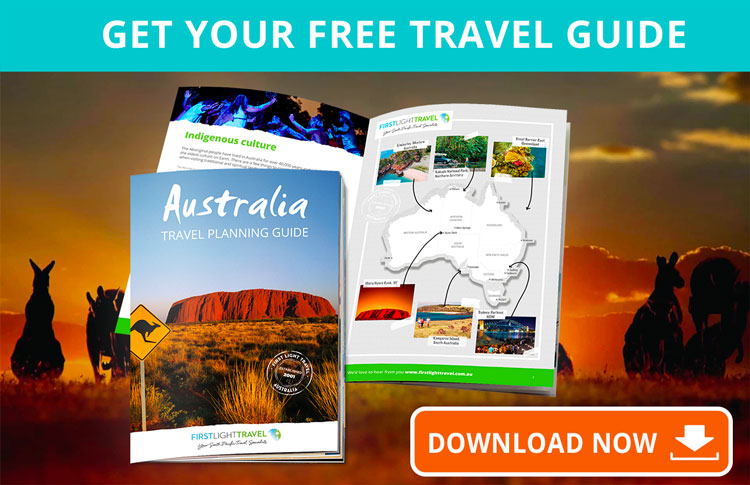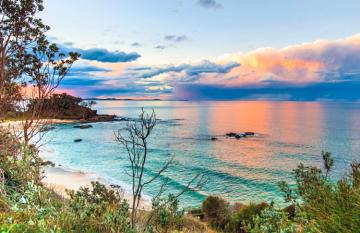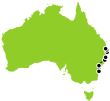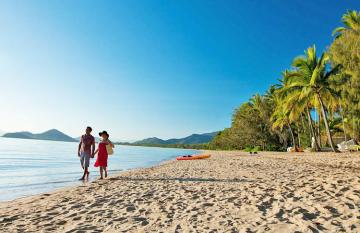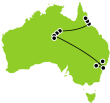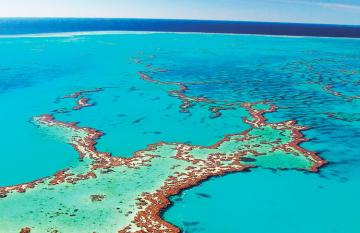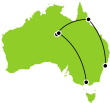
If you want to know the best way to visit the Blue Mountains, you’re in the right place. We’ve put together the ultimate guide to help you make the most of a trip including what to do, how to do it, and answers to frequently asked questions.
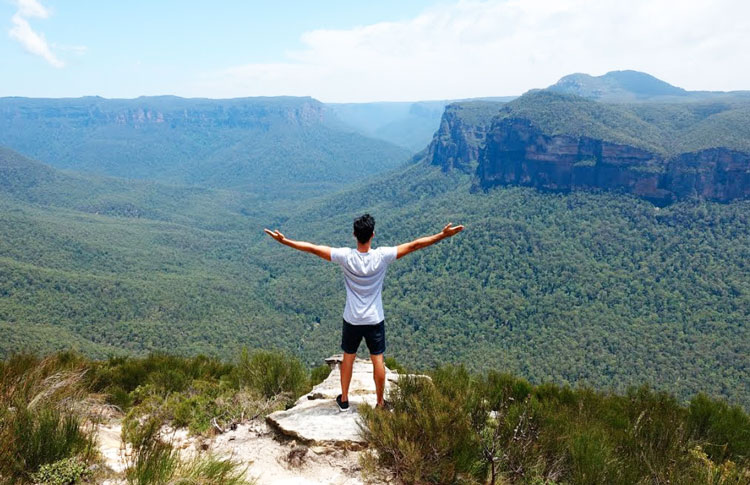
Just 90 minutes from Sydney, the Blue Mountains are a World Heritage Site of incredible natural beauty. Throw in plenty of adventure sports, bush walks, luxury spas and historic hotels, too, and you have one of Australia’s most unique travel destinations.
Ready to start planning your trip to the Blue Mountains? Let’s get started:
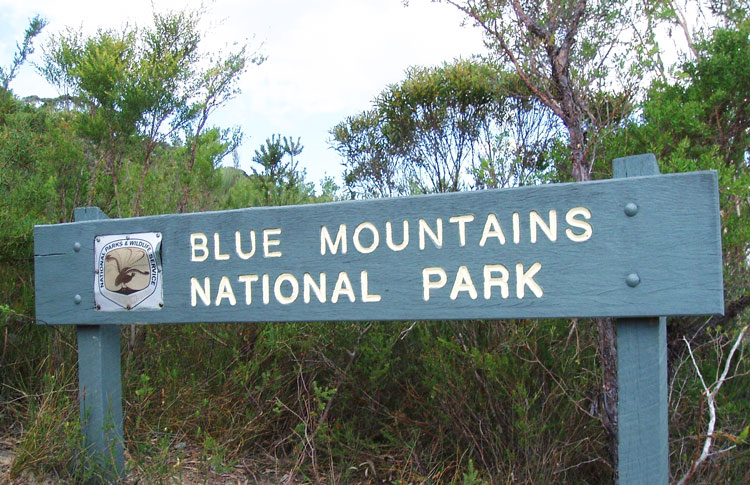
What are the Blue Mountains?
The Blue Mountains are a rugged, forested mountain range peeling off the Great Dividing Range in New South Wales. They feature towering sandstone cliffs, secluded canyons, dramatic waterfalls, unique rock formations, dense eucalyptus forests, and incredible underground caves.
The foothills of the Blue Mountains start just 50 km west of central Sydney, and the term is generally used to refer to the towns, rural areas, and mountainous wilderness west of Sydney, between Penrith and Bathurst.
What is so special about the Blue Mountains?
The Blue Mountains are special because they combine amazing scenery with some fantastic cultural sites and quirky villages.
Here are the top, must-do Blue Mountains highlights:
The Three Sisters: an iconic sandstone formation with panoramic views and intriguing Aboriginal history.`
Wentworth Falls: a towering, two-tiered waterfall cutting through forested mountainside.
Eucalyptus forests: vast, unspoilt areas of native eucalyptus trees and their ancient animal inhabitants.
Jenolan Caves: a world-renowned underground network of stalactites, stalagmites, and subterranean rivers that also hosts monthly concerts and a heritage-listed hotel. Learn more about the Jenolan Caves here.
Mount Tomah Botanic Gardens: historic estate and garden with thousands of exotic plant species, fantastic views, and the Blue Mountains Area World Heritage Exhibition Centre.
Katoomba Scenic Railway: the world’s steepest train, dropping 400 metres down a narrow gorge escarpment surrounded by trees. A huge hit with kids.
After those, what impresses you about the Blue Mountains will depend on what interests you. For example:
Enjoy award-winning dining in stunning locations
Food-lovers can look forward to eating at one of many exquisite restaurants and enticing eateries located throughout the Blue Mountains.
Established fine dining establishments include the old-world elegance of Darleys Restaurant at Lilianfels Resort, Wintergarden at the Hydro Majestic, set in a spectacular mountainside spot.
The modern Australian degustation at Embers, in Leura, and cutting-edge Fumo, in Blackheath, are among the Blue Mountains’ brightest contemporary culinary stars.
There are also award-winning cafes like the family-run Basil Nut, innovative Vincent Diner in Glenbrook, and industrial modern Boiler House at Medlow Bath.
Find out more about Australia's best-loved food & cuisine.
Rare flora and fauna in the Blue Mountains UNESCO World Heritage Area
The Greater Blue Mountains Area is a protected UNESCO World Heritage Site, mainly due to its rare eucalyptus forests. Species from all four eucalypt plant groups live here, including 114 endemic species and 120 rare or endangered species.
Over 400 animals also call the Blue Mountains home, from endangered reptiles like the Blue Mountain water skink to dingoes and wild predators. Rare marsupials include the spotted-tailed quoll and long-nosed potoroo, as well as resident koalas and kangaroos.
The historical Blue Mountains: taking a look back in time
As well as being a pristine natural area, the Blue Mountains are rich in culture and history.
If you want to learn about Aboriginal heritage and the traditional landowners of this region, the Gundungurra and Darug people, take a Blue Mountains Walkabout tour from Faulconbridge.
If you’d like to see what Blue Mountains towns were like during their 19th-century mining heyday, head to Yerranderie, an abandoned silver-mining town that has been well preserved.
And if you or your kids are mad about engines, don’t miss the hands-on displays of the Leuralla Toy and Railway Museum, or the historical holdings of the Valley Heights Locomotive Depot Heritage Museum.
The Blue Mountains have the best views in town
If you consider the Blue Mountains as an extension of Greater Sydney, then it’s undoubtedly where you get the best views in town – trust us, the Opera House can’t compete with this.
From Katoomba and the Three Sisters viewpoint at Echo Point, you get amazing views over the endless eucalyptus forests. But to get an even better vantage point of the Blue Mountains’ beauty, head to Scenic World and take the Scenic Skyway cable-car, Australia’s only glass-bottomed gondola.
If you’re really keen to get a bird’s-eye view, you can skydive in the Blue Mountains. Although it’s not the most relaxing way to take in the views, it’s certainly one of the most memorable.
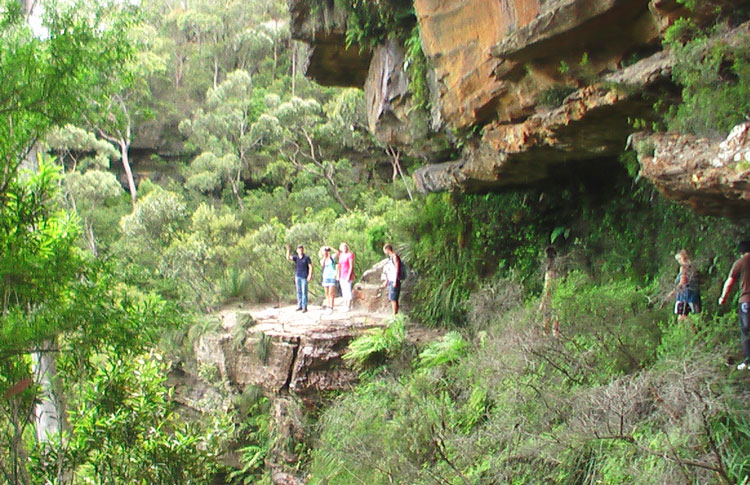
How do you get to the Blue Mountains?
No matter what means of transport you have, it’s easy to get from Sydney to the Blue Mountains in under two hours.
Getting from Sydney to the Blue Mountains by car:
Driving offers the best way to get to the Blue Mountains, as well as the freedom to get off the tourist trail and explore the area once you arrive.
From the city centre or eastern suburbs, head west and get on the M4 Motorway past Parramatta and Penrith. You’ll hit the entrance to the Blue Mountains at Glenbrook in about 50 minutes, Faulconbridge in 1 hour, Katoomba in 85 minutes, or Blackheath in 95 minutes from Sydney CBD.
Fancy a more scenic route? Here’s one for you:
The spectacular Bell’s Line road winds its way over bridges and through tunnels of the Blue Mountains National Park, offering stunning viewpoints at practically every turn. It starts in Richmond, about 55 minutes from central Sydney. From there, it should take just over one hour to Mount Victoria.
Getting from Sydney to the Blue Mountains by train:
It’s also quick and easy to get from Sydney’s CBD to the Blue Mountains by train. Thanks largely to the Blue Mountains Line.
Operated by NSW TrainLink, this train runs at least every hour throughout the day, from as early as 4:00 a.m. until midnight. It stops at all main Blue Mountains towns, as well as a few sight-seeing destinations.
From Sydney Central station, the Blue Mountains Line takes around 1h 24m to Faulconbridge, 1h 48m to Wentworth Falls, 1h 54m to Leura, 2h 4m to Katoomba, 2h 12m to Blackheath, and 2h 18m to Mount Victoria.
Don’t have much time? Here’s a fix:
If you’re in a hurry, the twice-daily ‘Bathurst Bullet’ express train shoots straight to Katoomba, 1h 45m from Sydney Central.
How to get around in the Blue Mountains
Driving
Having a car makes it easy to get around, since the major roads in the Blue Mountains are excellently maintained.
Local buses and coach services
You can also find plenty of local coaches and buses between most Blue Mountains towns and destinations. If you only have a day, the hop-on, hop-off Explorer Bus is a wise option. It takes you around 29 must-see sights throughout the Blue Mountains!
On Foot
In the small Blue Mountains towns, you can pretty much get around on foot. There are taxis available if need be.
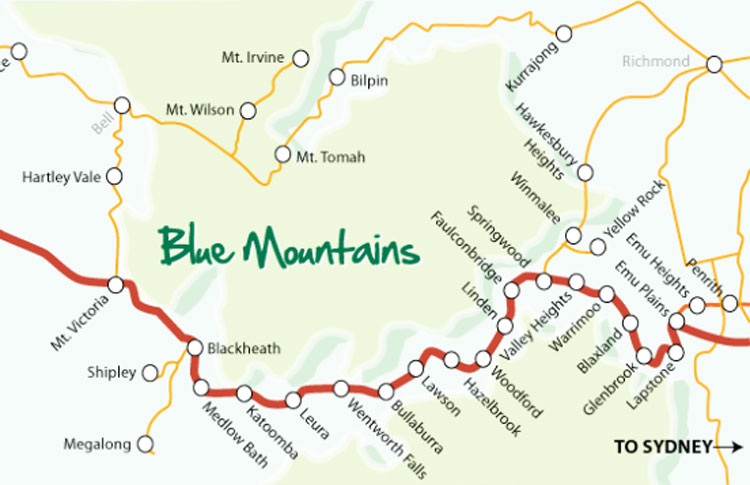
Discover the Blue Mountains’ charming towns and villages
Leura
The quintessential Blue Mountain town.
Tree-lined streets full of cafes, boutiques, art galleries, and even an old-timey lolly shop. The nationally-renowned Leura Gardens Festival takes place every Spring. Walk to Leura Cascades for a wonderful picnic spot.
Faulconbridge
A sleepy town surrounded by bush, Faulconbridge is full of pleasant surprises.
Here you’ll find the ‘Corridor of Oaks,’ an avenue of trees planted by successive Australian Prime Ministers, as well as the former home and gardens of renowned artist Norman Lindsay.
Wentworth Falls
A pretty village with spectacular nature views at every turn.
The pretty Charles Darwin Walk traces Jamison Creek to the Wentworth Falls Picnic Area. Then take the Wentworth Falls Track past the Jamison, Wentworth, and Fletchers lookouts. Wentworth Falls Lake offers another option for a relaxing day out.
Blackheath
Known for breathtaking lookout points, but with a lot more to discover.
Govetts Leap Lookout is the main reason most people visit Blackheath. The Campbell Rhododendron Gardens, open year-round, are the centre of Blackheath’s famous annual Rhododendron Festival. Don’t miss the unique antique and memorabilia market at the grand old Victory Theatre, either.
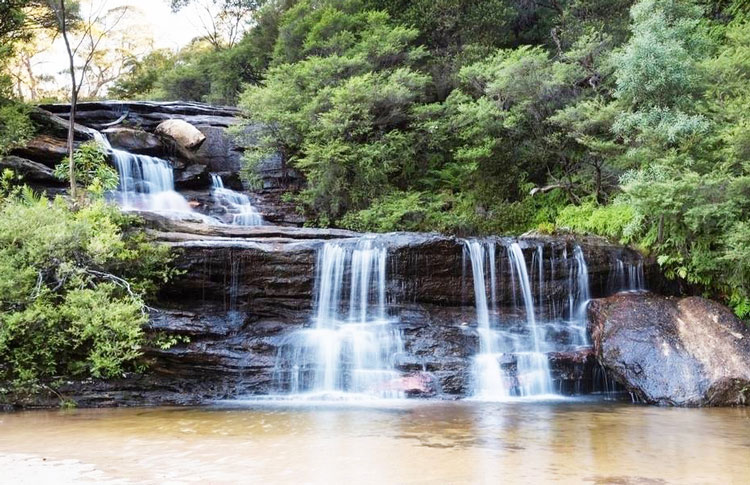
DO’s and DON’Ts in the Blue Mountains
It’s hard to go wrong when visiting the Blue Mountains. But still, there are some things you should do – and others you shouldn’t.
What NOT to do in the Blue Mountains:
1) DON'T climb the Three Sisters
This precious rock formation is off limits to rock climbers. As are other parts of the Blue Mountains National Park.
Don’t worry – the NSW National Parks and Wildlife Service designates plenty of other places to climb within the Blue Mountains National Park. In addition, the Blue Mountains City Council manages popular climbing sites on Crown Land, including the famous Western Escarpment cliffs.
2) DON'T be under-prepared
If you’re asking yourself, ‘What should I wear to the Blue Mountains?’ then you’re doing better than a fair number of visitors.
Given its proximity to the city, many travelers think they can get away with a t-shirt and flip-flops on a trip from Sydney to the Blue Mountains. Oftentimes they’re right. But do remember that this is a mountainous natural wilderness area.
As such, the weather can change quickly. It won’t hurt to throw in a light raincoat and a warmer layer, just in case. And even in the best of conditions walking tracks can be challenging, so it’s always wise to bring sturdy footwear with good grip.
Staying safe while travelling in Australia
3) DON'T Rush it
The Blue Mountains is a big area, with lots to explore. Don’t count yourself among the many travelers who rush through and only see the surface of it. Relax, settle in, and take a bit of time to dig deeper and explore. You’ll discover a whole lot of surprising and memorable experiences.
What TO do in the Blue Mountains:
The number one thing you should do in the Blue Mountains is get moving! Here are some outdoor activities and adventures to try in the Blue Mountains:
1) DO go hiking and bushwalking
With over 140 kilometres of marked hiking trails, a trip to the Blue Mountains offers an endless range of great bushwalks.
Multi-day hiking trails and bushwalks
The ‘Six Foot Track’ takes a full 3 days, following an old 1884 horse track from Katoomba to the Jenolan Caves
A 2-day Glow Worm Cave Walk in the Wolgan Valley offers an alternative view into the Blue Mountains subterranean world and its inhabitants.
Full day and half-day bushwalks
From Wentworth Falls picnic area, the 4.5-kilometre National Pass loop trail takes around 3 hours. It passes several sweeping viewpoints and lookouts en route to the legendary Grand Stairway, then into the Valley of the Waters where you get views of the Empress, Silvia, and Lodore Falls.
The Giant Stairway, descending down a cliff into the Jamison Valley near the Three Sisters, offers a superb alternative route from Echo Point to Scenic World. The 4.7-kilometre walk is a bit of a challenge, with plenty of up and down. It should take between 2 and 3 hours.
Short and sweet bushwalks
The Princes Rock Walk covers only a few kilometres, but takes in brilliant views of Wentworth Falls, Kings Tableland and Mount Solitary along the way.
More active travelers will enjoy the 3-kilometre Glenbrook Gorge trail, which lets you wade through rivers and jump from boulder to boulder through some gorgeous gorge scenery.
The gentle 1-kilometre track from Echo Point to the Three Sisters via beautiful Honeymoon Point takes about 40 minutes. It’s a tad longer than the much busier main track, but well worth the extra minutes.
Guided Blue Mountains bushwalks
Provided you’ve got the right gear and your wits about you, all of these trails are easy to do on your own. But if you’d rather leave it in the hands of the experts, many excellent tour companies operating in the Blue Mountains offer guided hikes and bush walks.
- ‘Life’s An Adventure’ have a huge range of options, from short day walks to multi-day themed excursions.
- ‘Tread Lightly Eco-Tours’ make sure you enjoy the natural beauty of the Blue Mountains, in a way that will help ensure it’s there for future generations to enjoy, too.
- ‘Blue Mountains Walkabout’ let you learn about the traditional land owners and ancient occupants of the Blue Mountains, providing Aboriginal heritage tours with a knowledgeable local Darug guide.
2) DO try some Adventure Activities
Mountain biking in the Blue Mountains
If you want to experience the Blue Mountains by bike, you’ll find plenty of enticing options.
Known as the ‘Fire Trails,’ these are some of the most popular tracks. Taking you into some heavily forested, remote sections of the Blue Mountains:
Narrow Neck Trail offers superb views from along the raised Narrow Neck Peninsula. At its narrowest point the cliffs fall away on each side, revealing the Jamison Valley directly below you on one side, and the Megalong Valley on the other.
The challenging Andersons Fire Trail is an exhilarating, 31-kilometre gravel trail between Wentworth Falls and Woodward. It features some ultra steep sections and spectacular drops, challenging even the most experienced of riders.
Rock climbing in the Blue Mountains
A great way to see every nook and cranny of the Blue Mountains up close.
Multiple local companies offer guided tours, ranging from beginner to expert. Or if you’re confident and experienced, with your own gear, you can tackle the non-restricted parts of the Blue Mountains on your own. Most of the best areas for rock climbing are around the famed cliffs of the Western Escarpment.
3) Alternatively, DO chill out! Enjoy spas and relaxation in the Blue Mountains
There are many spas and wellness retreats located in the Blue Mountains. Here’s a few of the best:
Blue Mountains Sparadise, South Bowenfels.
Hidden away in an idyllic mountain setting, this slightly cringe-ily named spa retreat is the only genuine Japanese bath house in NSW. It offers day- and half-day packages guaranteeing complete zen and relaxation.
Spa Sublime, Katoomba.
A secluded day spa with a comprehensive treatment menu literally covering from head to toe. They offer sessions from half an hour to a full day, as well as special packages for couples or small groups.
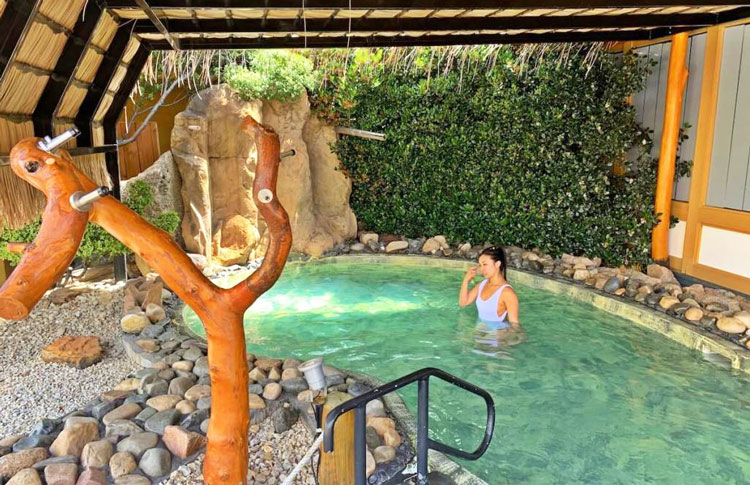
Where are the best places to stay in the Blue Mountains?
The answer to this question might come down to budget and taste.
Historic Hotels in the Blue Mountains
If price is not an issue, don’t look past the Blue Mountains exquisite heritage hotels. Blending old-world charm, modern comforts and simply stunning locations, these are some of Australia’s very best luxurious lodgings:
Majestic Hydro Hotel
The Carrington Hotel, Katoomba
Fairmont Resort Blue Mountains, Leura
Lilianfels Resort
Jenolan Caves Hotel
Bed and breakfasts, boutique homestays, and self-catering cottages
If you’d rather focus on making the most of daytime activities and adventures in the Blue Mountains, you’re probably just looking for a good night’s sleep. And why not add some creature comforts, charm, and gorgeous locations?
Here are some suggestions that fit the bill:
Buddens Bed & Breakfast provides historic accommodation on a smaller scale than the hotels. Housed in the renovated old bank, built in 1872, in the sleepy town of Rockley.
Billabong Cottage Trout Fishing Farm Stay lets you stay on a working cattle and sheep farm with private (sealed) access to your own trout stream.
The Bush Hut, a stone’s throw from Wentworth Falls, has floor-to-ceiling windows to make the most of a truly secluded and private setting, totally surrounded by bushland.
The Woolshed Cabins near Blackheath are comfy, cosy cottages set on quiet farmland with sensational views straight onto the Blue Mountains cliffs. Particularly pretty under snow cover on crisp winter mornings.
Camping in the Blue Mountains
Immerse yourself totally in nature, falling asleep to the sounds of bushes rustling and rivers gurgling. Then wake up to breathtaking mountain vistas over hazy forests.
If you just need a place to pitch your tent or park your caravan:
Jenolan Holiday Park. Located in the heart of Oberon, near Kanangra Boyd National Park and Evans Crown Nature Reserve. Large powered and non-powered sites, plus budget and premium cabins.
Katoomba Falls Tourist Park. Within walking distance to the Three Sisters Lookout, Katoomba town, and Scenic World. 25 powered and 21 unpowered camping sites. Free WiFi.
Blackheath Glen Tourist Park. Located in secluded bushland at Pope’s Glen, feels like the wilderness but a short walk from Blackheath town centre. Grassy, slab, and ensuite sites.
Ready to go? Start planning your Blue Mountains trip today!
Well, there you have it. It’s safe to say that the Blue Mountains holds something for every traveler. From luxury spa retreats to challenging hiking and cycling trails, it depends on what you want from your next holiday.
If you like the idea of visiting the Blue Mountains, but you’re still not quite sure how to go about it, don’t worry. Why not try using the First Light Travel planning service to give you a clearer idea? It’s totally free, and it will give you a clearer idea on what to expect with prices, timings, and availability.
More Articles to Help You Create Your Dream Trip To Australia
Australia Trip Planning Guide
Australian weather, temperatures & rainfall
Our informative Australia Travel Blog
Trip Inspiration: Amazing Australian Landscapes
Travelling Safely in Australia
Recent Posts
Blog Categories
Blog archives
- April 2024 (1)
- March 2024 (13)
- February 2024 (3)
- January 2024 (5)
- December 2023 (6)
- November 2023 (4)
- October 2023 (11)
- September 2023 (2)
- August 2023 (6)
- July 2023 (2)
- June 2023 (17)
- May 2023 (3)
- April 2023 (5)
- March 2023 (8)
- February 2023 (9)
- January 2023 (12)
- December 2022 (9)
- November 2022 (12)
- October 2022 (12)
- September 2022 (12)
- August 2022 (6)
- July 2022 (9)
- June 2022 (7)
- May 2022 (3)
- April 2022 (4)
- March 2022 (6)
- February 2022 (1)
- January 2022 (4)
- December 2021 (2)
- November 2021 (3)
- October 2021 (1)
- September 2021 (4)
- August 2021 (10)
- July 2021 (13)
- June 2021 (6)
- April 2021 (2)
- March 2021 (2)
- February 2021 (1)
- January 2021 (1)
- December 2020 (2)
- November 2020 (3)
- October 2020 (2)
- September 2020 (1)
- August 2020 (1)
- July 2020 (1)
- June 2020 (1)
- May 2020 (1)
- April 2020 (1)
- March 2020 (1)
- February 2020 (2)
- January 2020 (4)
- December 2019 (2)
- November 2019 (1)
- October 2019 (1)
- September 2019 (5)
- August 2019 (1)
- July 2019 (5)
- June 2019 (1)
- May 2019 (1)
- April 2019 (1)
- March 2019 (1)
- February 2019 (1)
- January 2019 (1)
- December 2018 (1)
- October 2018 (1)
- May 2018 (1)
- February 2018 (1)
- December 2017 (1)
- October 2017 (1)
- June 2017 (1)
- May 2017 (1)
- February 2017 (1)
- January 2017 (1)
- September 2016 (1)
- August 2016 (2)
- July 2016 (1)
- June 2016 (1)
- May 2016 (1)
- April 2016 (1)
- December 2015 (1)


